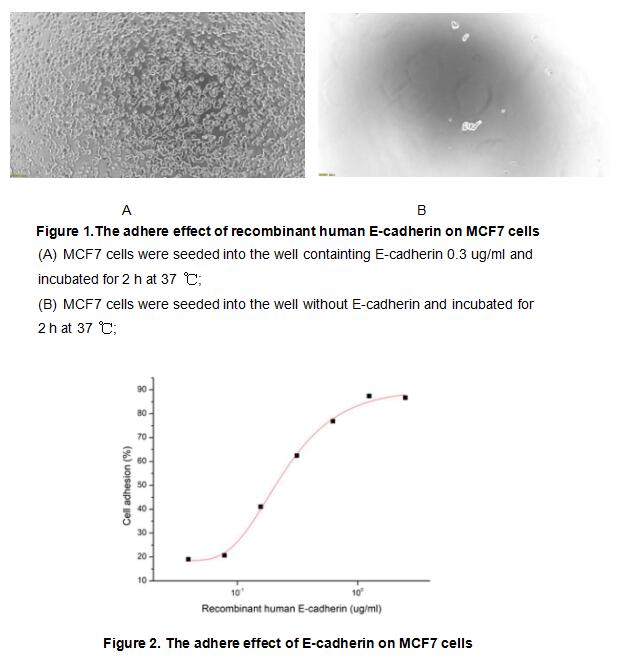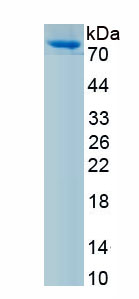Active E-cadherin 

CDHE; CD324; CDH1; Arc1; ECAD; CDH-E; E-CAD; LCAM; UVO; Cadherin 1 Type 1; Uvomorulin; E-Cadherin; Calcium-Dependent Adhesion Protein, Epithelial; Liver Cell Adhesion Molecule
Overview
Properties
- Product No.APA017Hu62
- Organism SpeciesHomo sapiens (Human) Same name, Different species.
- ApplicationsCell culture; Activity Assays.
Research use only - DownloadInstruction Manual
- CategoryCD & Adhesion moleculeTumor immunity
- Buffer FormulationPBS, pH7.4, containing 5% Trehalose.
- Traits Freeze-dried powder, Purity > 90%
- Isoelectric Point4.0
Sign into your account
Share a new citation as an author
Upload your experimental result
Review

Contact us
Please fill in the blank.
Activity test

E-Cadherin, also known as Uvomorulin in the mouse and rat, is a 120 kDa member of the Cadherin family of cell surface glycoproteins that mediate cell adhesion. Human E-Cadherin shares 81% amino acid sequence identity with the rat and mouse proteins. It is a single-pass transmembrane protein that mediates calcium-dependent epithelial cell adhesion. As E-cadherin has the function of cell adhesion, we measure the activity of recombinant human E-cadherin by the ability of the immobilized protein to support the adhesion of MCF7 human breast cancer cells. When 5 x 104 cells/well are added to different concentrations of recombinat human E-cadherin coated plates, cells will adhere after 2 hour incubation at 37 ℃. The adhesion of MCF7 after 2 hour incubation at 37 ℃ observed by inverted microscope was shown in Figure 1. Cell adherent was in a dose dependent manner, the result was shown in Figure 2, the EC50 was 0.23 ug/ml.
Usage
Reconstitute in 10mM PBS (pH7.4) to a concentration of 0.1-1.0 mg/mL. Do not vortex.
Storage
Avoid repeated freeze/thaw cycles. Store at 2-8°C for one month. Aliquot and store at -80°C for 12 months.
Stability
The thermal stability is described by the loss rate. The loss rate was determined by accelerated thermal degradation test, that is, incubate the protein at 37°C for 48h, and no obvious degradation and precipitation were observed. The loss rate is less than 5% within the expiration date under appropriate storage condition.
Increment services
-
 BCA Protein Quantification Kit
BCA Protein Quantification Kit
-
 Molecular Mass Marker for Protein
Molecular Mass Marker for Protein
-
 Monoclonal Antibody Customized Service
Monoclonal Antibody Customized Service
-
 Polyclonal Antibody Customized Service
Polyclonal Antibody Customized Service
-
 Protein Activity Test Experiment Service
Protein Activity Test Experiment Service
-
 Electrophoretic Mobility Shift Assay (EMSA) Experiment Service
Electrophoretic Mobility Shift Assay (EMSA) Experiment Service
-
 Buffer
Buffer
-
 Lentivirus Packaging Experiment Service
Lentivirus Packaging Experiment Service
-
 Adenovirus Packaging Experiment Service
Adenovirus Packaging Experiment Service
-
 Real Time PCR Experimental Service
Real Time PCR Experimental Service
-
 Spike RBD Protein (S-RBD)
Spike RBD Protein (S-RBD)
-
 Protein G
Protein G
-
 Protein A
Protein A
Citations
- Novel method for proliferation of oral keratinocyte stem cellsPubmed: 24329011
- Modulation of the Dual‐Faced Effects of miR‐141 with Chitosan/miR‐141 Nanoplexes in Breast Cancer CellsPubmed: 31389101
- BST2 regulates interferon gamma-dependent decrease in invasion of HTR-8/SVneo cells via STAT1 and AKT signaling pathways and expression of E-cadherinPubmed: 31957537
- Personalized Approach to Determination of Histidine-Rich Glycoprotein and E-Cadherin in Supernatants of Immunocompetent Blood Cells and Breast Biopsy …Pubmed: 32342301
- Non-POU Domain-Containing Octamer-Binding (NONO) Protein Stability Regulated by PIN1 is Crucial for Breast Cancer Tumorigenicity Via the MAPK/β …







